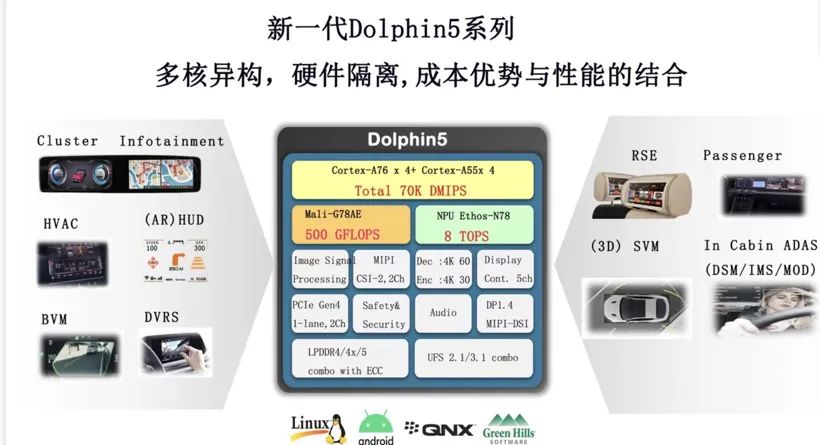
Join the automotive industry group, please add WeChat gasgoo88 and show your business card
Currently, leading new energy vehicle manufacturers have gradually completed the upgrade and transformation of their electronic and electrical architecture, shifting from distributed to domain-centric systems, with some even beginning to show early forms of centralized computing architecture. The deeper pursuit of intelligent features by consumers has not only intensified competition among manufacturers but also brought unprecedented opportunities for automotive AI chips.
According to Gartner, the global automotive AI chip market is expected to grow to $23.6 billion by 2025, with the Chinese market accounting for $6.8 billion of that. By 2030, this figure is expected to further increase to $12.4 billion, with a compound annual growth rate of 28.14%.
This is destined to be a disruptive era. During the traditional distributed E/E architecture period, companies like Renesas, NXP, and Texas Instruments held the majority of the automotive chip market share. Subsequently, Qualcomm leveraged its vast consumer electronics business advantage to demonstrate overwhelming dominance in the smart cockpit sector. Currently, the standard solutions for mainstream mid-to-high-end smart vehicles in China revolve around “Qualcomm Snapdragon 8155 + NVIDIA Orin,” but as the interaction modes between humans and vehicles become increasingly complex and the cycle for new model updates shortens, new product solutions are emerging.
The Frenzied Smart Cockpit: Killing the SoC

Image Source: Telechips Inc.
If the power battery is the heart of future vehicles, then the automotive AI SoC is akin to the brain. Data shows that the penetration rate of intelligent configurations in new vehicles in the Chinese market is around 50%, and it is expected to exceed 75% by 2025. The industry generally believes that the smart cockpit has entered the 2.0 era, where new and old players are in fierce competition, and more comprehensive product solutions have become a company’s core competitiveness.
Telechips Inc., which has been deeply involved in the automotive chip field for many years, clearly has a voice in this matter. In 2011, Telechips defeated NXP to become the IVI chip supplier for Hyundai’s mid-range models. In recent years, Telechips has continued to expand its chip supply to Hyundai. In 2021, Telechips’ smart cockpit chip Dolphin 3 was first shipped to Chinese automotive brands and achieved mass production in the same year. This year, the new generation cockpit solution Dolphin 5 is also set to be unveiled, with mass production expected in 2024.
Dolphin 5 is a heterogeneous integrated automotive-grade SoC, featuring ASIL-B compliant functional safety design, and includes CPU, GPU, ISP, NPU, and high-bandwidth low-latency LPDDR4/LPDDR5 memory channels, providing comprehensive computing power support for smart cockpit applications. This chip is built on an advanced 8nm low-power process, with CPU performance exceeding 70K DMIPS, supporting five display outputs and eight video inputs. Compared to the previous generation chip, Dolphin 5’s computing power has increased by 1.5 times, and NPU performance has increased eightfold to 8 TOPS, comparable to Qualcomm Snapdragon 8155.
The accelerated upgrade of cockpit intelligence means that the amount of data to be processed is becoming increasingly vast, reflecting a growing demand for computing power in the chip sector. As the richness of cockpit functions continues to increase, not only is there a need for interaction between multiple screens, but higher-level applications such as desktop gaming are also accelerating their entry into vehicles, all of which place higher demands on the cockpit’s main control “brain.”

Image Source: Telechips Inc.
For example, a single Dolphin 5 can simultaneously run dual systems for the automotive LCD instrument cluster (Cluster) and infotainment (IVI). Based on a hardware isolation design, the two systems can operate relatively independently when accessing hardware resources in parallel. The built-in Cortex-R5 runs a high real-time, high-reliability RTOS system as a super monitor, allowing for individual resets of a system in case of issues, ensuring that functionalities do not interfere with each other.
Compared to dual-chip dual systems, a single-chip dual system meets the diverse application scenarios of vehicles while effectively reducing material costs (BOM). Each system’s relative independence and technology reusability can also shorten the product development cycle for manufacturers and accelerate the pace of market entry.
Notably, in the face of the increasing complexity, precision, and bandwidth issues of wireless communication in the 5G era, Telechips has achieved software-defined radio (SDR) capabilities for Dolphin 5 through its software capabilities.
SDR utilizes programmable DSP technology to replace traditional analog systems composed of RF filters, modulator chipsets, etc. In simple terms, it is a core technology that allows for multiple broadcasting systems to be implemented by merely changing software without needing to replace hardware. For vehicles exported to different countries, software solutions can be adjusted to meet the broadcasting system requirements of different regions such as Europe, North America, and India, significantly reducing costs and increasing development convenience and efficiency.
Of course, no matter how good the technology is, only practice can reveal the truth. According to reports from Gaishi Automotive, Dolphin 5 can support up to five screens with a power consumption of only 13.5W. Moreover, this SoC supports fast booting; for instance, the Linux system can start within 2 seconds.
The Everest of AI: Daring Climbers
For this South Korean unicorn, the rapid growth of China’s new energy vehicles may become a key force in once again disrupting the automotive AI chip market. The battle for cockpit chips has already begun, and the competition for autonomous driving SoCs is equally fierce. Currently, the penetration rate of L1 and L2 level autonomous vehicles among sold models worldwide has exceeded 50%. In the first half of 2022, the penetration rate of L2 level autonomous passenger cars in China rose to 30%.
Therefore, this year, Telechips will also launch the N-Dolphin series of autonomous driving SoCs to secure a place in this still-maturing market. N-Dolphin uses 14nm process technology, with CPU performance of 13K DMIPS and AI performance of 8 TOPS, while also integrating ISP for higher levels of integration, supporting camera inputs of up to 5.4MP at 60fps, and connecting up to four cameras.
This chip is primarily used for target monitoring in front ADAS cameras, driver monitoring, cabin monitoring systems (DMS/IMS), and electronic rearview mirrors, effectively recognizing information such as pedestrians, vehicles, bicycles, motorcycles, traffic signs/signals, and road surfaces. When used in ADAS cameras, its power consumption is as low as 3W to 5W. Additionally, N-Dolphin supports T-RVM (Trust-Rear View Mirror) with hardware functional safety, ensuring that even if the CPU crashes, camera inputs can continue to display output.
Compared to cockpit chips, autonomous driving SoCs have already entered a “beyond-class” race in terms of computing power. For example, NVIDIA’s Thor chip achieves a computing power of 1000 TOPS, which is more than ten times the 72 TOPS of Tesla’s FSD single chip. Especially with the rising popularity of ChatGPT, the demand for computing power seems boundless. However, in reality, to evaluate a chip’s quality, computing power is just one dimension. Among two chips with the same computing power, the one that allows software to run more efficiently is the better chip.
There are also viewpoints suggesting that as cross-domain integration becomes a trend, some functions based on vehicle safety and real-time processing needs may merge into the cockpit domain. Some automakers may choose SoC chips from the same supplier in the future, primarily because software compatibility can be better achieved. This is precisely Telechips’ advantage.
According to plans, Telechips will launch the 8nm 120K DMIPS Dolphin 7 chip between 2024 and 2025; it also plans to release the 8nm 250 TOPS A2X autonomous driving chip that can connect 12 cameras in 2024.
In addition to cockpit and ADAS chips, Telechips also has gateway chips, MCUs, and other automotive-grade product lines. Earlier, Telechips invested in the establishment of a company focused on battery management chips for new energy vehicles, Autosilicon, which has successfully developed the ATS7001 and ATS7001ATS7002 series that have passed the highest automotive safety certification of ASIL-D, expected to have been mass-produced by the end of 2022 and officially enter the Chinese market.
As vehicles become increasingly intelligent and connected, Telechips has segmented market demands and planned SoC, MCU, ADAS, Gateway, and BMIC chip products at different performance and price levels, with some product lines adopting a PIN TO PIN solution, allowing customers to achieve product upgrades at lower costs and with greater convenience.
As a globally positioned chip design company, Telechips has stable foundry capacity in the United States, South Korea, and Taiwan, providing customers with more flexible supply channels and shorter delivery times. Additionally, FAE and sales teams are stationed in Shanghai, Shenzhen, Dalian, and other locations in mainland China to quickly respond to customer technical support needs and resolve technical issues in a timely manner.
The new energy vehicle market seems full of opportunities, but it also presents many challenges. After all, the intelligence of vehicles has not reached its final stage; to survive until the end, one must demonstrate true capabilities and a comprehensive service system advantage.
-END-
If you liked this article, please give me a thumbs up!
